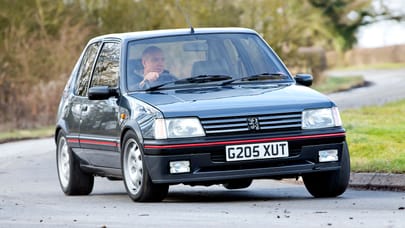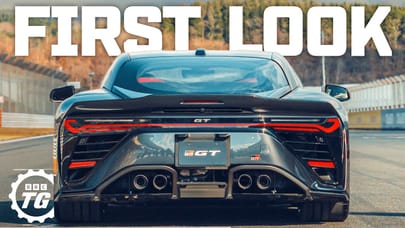

Being avaricious students of the Internet, you will, no doubt, be aware that Ferrucio Lamborghini started his sportscar company following a less-than-acceptable meeting with Enzo Ferrari.
But what you probably won't know is that he served in World War II, was released from British captivity as a prisoner of war, began his tractor business to help regenerate post-war Italy's agricultural industry, started a heating and ventilation business and even attempted to found a helicopter firm.
These businesses afforded him a rude financial health that he correctly spent on a fleet of exotic metal. None of which pleased this brutally honest and upfront Italian. He wanted a car that epitomised grand touring. And the perfect GT car needed a big, bold engine. A big, bold V12 engine...
Advertisement - Page continues belowLamborghini 350 GTV

Framing your entire supercar business on ‘if you want something done properly, do it yourself' was a risky strategy; a strategy that bore its first fruit at the 1963 Turin motor show when Ferrucio premiered the Lamborghini 350 GTV.
Lamborghini 350 GTV

The 350 GTV was simply a prototype - a blueprint of Lambos to come - and featured a racing-spec 3.5-litre V12 designed from scratch by Giotto Bizarrini producing around 350bhp and 240lb ft of torque. Rumour has it the engine had a ‘roar worthy of the top racing V12s'...
Advertisement - Page continues belowLamborghini 350 GT

But despite this herculean feat of birthing a supercar with a brand-new V12 from scratch, the impetuous Ferrucio was still dissatisfied. He restyled the GTV's body - turning to Carrozzeria Touring - and detuned its hard-edged racing V12 for something a little more sober and acceptable for long-distance touring.
Lamborghini 350 GT

The 3.5-litre quad-cam V12 now produced 320bhp thanks to softened cam profiles, a lower compression ratio (making it less highly strung) and by replacing the dry sump system with a conventional wet sump oil pan.
Despite the changes though, the 350 GT could still hit a top speed of 156mph, and this car cemented Lamborghini's future: from 1964-1966 120 GTs were built.
Lamborghini 400 GT

Ferrucio was on to something now - he immediately replaced the 350 with the larger, 2+2 400 GT, featuring an enlarged 4.0-litre V12 that still produced 320bhp and headlined at 155mph.
Lamborghini 400 GT

Mr Lamborghini rather liked this engine, and the last 23 350 GTs were in fact, all fitted with this larger 4.0-litre twelve pot. 250 400 GTs were built between 1966 to 1968, and this engine would also see service in the Lamborghini Espada (in both 325bhp and 350bhp format), the front-engined Lamborghini Islero and something called a ‘Miura'...
Advertisement - Page continues belowLamborghini Miura

Don't thank Ferrucio for the Miura. He was vehemently against the notion of a thoroughbred, fire-spitting road racer, instead preferring the quiet and powerful luxury of grand touring. No, his two top engineers - Dallara and Stanzani - built a prototype mid-engined racer in the spirit of the Ford GT40 in their spare time, and presented it to the headstrong boss. They expected a torrent of swearing delivered in rural Italian dialect, and perhaps a P45. What they got was a big fat thumbs up.
Lamborghini Miura

It had the 4.0-litre V12 from the 400 GT transversely mounted behind the cockpit, producing 350bhp in its first iteration, 370bhp in the Miura S and 385bhp in the Miura SV.
And that body, that body. It made Bertone stylist Marcello Gandini an overnight sensation, and remains to this day one of the prettiest supercars ever built.
Advertisement - Page continues belowLamborghini Countach

If the Miura epitomised beauty and spirit, the Countach prefixed Lamborghini's outrageous streak. Witness the scissor doors and that wedge-shaped, Gandini-designed body. All conceived and built in the eye of the 1973 oil crisis, financial uncertainty for the company and just before Ferrucio himself sold his shares, waved goodbye and retired to make wine.
Lamborghini Countach

The first ‘LP400' Countach used the Miura's 4.0-litre V12, producing 375bhp, while that engine would swell in size to 5.0-litres and finally 5.2-litre for later variants including the ‘25th Anniversary' model, producing 455bp and four valve tech for the first time in a Lambo V12.
Lamborghini Diablo

Lamborghini had, at this point, been through the mills somewhat. Multiple bankruptcies meant limited production and in 1987, brought it under the auspices of the Chrysler group, who took Marcello Gandini's Countach-successor designs and Americanised it. The result, despite this interference, is the Diablo. And it's fast.
Lamborghini Diablo

Powered by a bored-out version of the old V12, the 5.7-litre unit produced 492bhp, 428lb ft of torque and a top speed of 201mph, making it the fastest production car in the world at the time. It marked a good period for the company too, which finally managed to turn a profit thanks to its new, scissor-doored supercar.
Various iterations would follow, including the VT version with the four-wheel-drive system pinched from the LM002, the 510bhp SV and the 6.0-litre, 575bhp SE with a top speed of 205mph.
Lamborghini Murcielago

The first V12 supercar to emerge from behind Lamborghini's Audi-owned doors was the Murcielago; so named after a famous fighting bull that survived 28 sword strokes in the late 1800s, and was later presented as a gift to a noted breeder. That breeder was called ‘Miura'...
The Murcielago bore a 6.2-litre V12 when it first appeared, immediately signing its name to a Lamborghini engine heritage that started in the ‘60s. That 572bhp powered a 0-60mph time of 3.8 seconds and a top speed of 205mph. Naturally.
Lamborghini Murcielago

At the 2006 Geneva motor show the Murci' sported an enlarged V12, now at 6.5-litres and with power up to 640bhp, and this engine saw service in the limited edition, jet-fightery Reventon and the run-out, bells-and-whistles and mostly orange LP670-4 SV. That car, that bewinged, tango-liveried behemoth with 670bhp made Richard Hammond a very happy camper.
Its replacement had very big, V12-sized shoes to fill...
Lamborghini Aventador

A brand-new, hand-built 6.5-litre V12 debuted in the new Aventador, producing 700bhp and 500lb ft of torque, a V12 that weighs 235kg and revs to 8,250rpm. It sounds quite nice, too, as you no doubt heard from last night's show.
Lamborghini Aventador

The Aventador accelerates from 0-62mph in 2.9 seconds and rockets on to a top speed of 217mph. In the pantheon of fast, that's classified as ‘very'. Yours for £202,000.
More from Top Gear
Trending this week
- Car Review
BMW 1 Series
- Top Gear's Top 9
Nine dreadful bits of 'homeware' made by carmakers







